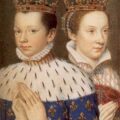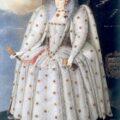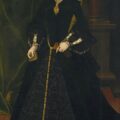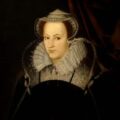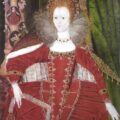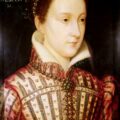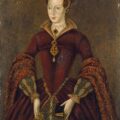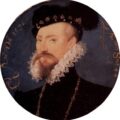Elizabeth Talbot, Countess of Shrewsbury, who has gone down in history as Bess of Hardwick, was buried on this day in Tudor history, 4th May 1608.
I prepared a video on her last February, to coincide with the anniversary of her death, but was ill so my dear husband Tim recorded it instead. Here it is:
And here is the transcript:
On this day in history, 13th February1608, in the reign of King James I, prominent Tudor noblewoman and one of the richest people in England, Elizabeth Talbot, Countess of Shrewsbury, more commonly known as Bess of Hardwick, died at her home at Hardwick. Her body lay in state at Hardwick until her funeral at All Hallows, Derby (now All Saints’ Cathedral), on 4th May 1608.
Here are some facts about this interesting Tudor lady:
- Bess was born in around 1527 and was the daughter of John Hardwick of Hardwick in Derbyshire, and his wife, Elizabeth Leake.
- Even though the family was of the gentry class and had been moderately wealthy, circumstances changed when Bess’s father died and the Crown seized quite a lot of his land. Until his eldest son came of age, this land and the money it made, would be controlled by those who held the boy’s wardship. This made things financially hard for the family.
- Bess was married to her first husband, Robert Barlow, by May 1543, when she was around 16. It seems, however, that the marriage was not consummated before Barlow died in December 1544.
- In August 1547, Bess married her second husband, widower Sir William Cavendish, Treasurer of the King’s Chamber, in the chapel at Bradgate Manor, the home of the Grey family in Leicestershire. Historian Elizabeth Goldring writes of how the pair were well-matched, as they “shared a fierce ambition for social advancement”. Bess had 8 children by Cavendish, and six of them survived childhood. Godparents to their children included Princess Elizabeth, the future Elizabeth I; John Dudley, Duke of Northumberland; William Herbert, Earl of Pembroke, and Lady Jane Grey.
- Bess is today remembered for her building projects, and these projects started in 1549, when Cavendish bought the Chatsworth estate and the couple began rebuilding it. They also bought further land and properties in Derbyshire and in joint names, which Goldring points out was a shrewd move as it prevented the problem that Bess’s own family had experience, i.e. lands and properties falling into wardship if Cavdendish died before his eldest son reached his majority, which he did in 1557 when his son, Henry, was just 7. Cavendish did, however, leave Bess with a debt of over £5000 owed to the crown.
- Due to her financial situation, Bess married again quickly, marrying her third husband, wealthy widower and nobleman Sir William St Loe sometime in 1557 or 1558. St Loe served Queen Elizabeth I as Captain of the Guard and Bess was appointed as a gentlewoman of the queen’s privy chamber. Bess ended up being dismissed by the queen, though, after she supported the secret marriage of Katherine Grey, sister of the late Lady Jane Grey, and Edward Seymour, Earl of Hertford. The St Loe marriage was childless and Bess was the main beneficiary of St Loe’s estate when he died in around 1565.
- In November 1567, Bess married for a fourth time, marrying the rich and powerful George Talbot, 6th Earl of Shrewsbury, owner of Tutbury Castle, Pontefract Castle, Sheffield Castle, Sheffield Manor, and other manors, lodges and properties. As well as Bess marrying Shrewsbury, Bess’s daughter, Mary, married Shrewsbury’s son, Gilbert, and Bess’s son, Henry, married Shrewsbury’s daughter, Grace.
- In 1568, a year after Bess married him, Shrewsbury was appointed as Mary, Queen of Scots’ keeper, and in 1569, Mary was installed with the couple at Tutbury. Shrewsbury acted as Mary’s keeper from 1568 to 1584 with Mary being kept at Tutbury on 4 separate occasions, and also his properties of Wingfield Manor, Chatsworth, Rufford Abbey and Sheffield.
- When Margaret Douglas, Countess of Lennox, visited Mary, Queen of Scots, and the Talbots at Rufford Abbey in 1574, Bess took the opportunity to arrange a match between Margaret’s son, Charles Stuart, and her daughter Elizabeth Cavendish. The two married and had a daughter, Arabella or Arbella Stuart in 1575. Both Shrewsbury and the queen, who were both in the dark concerning the marriage, were furious.
- Bess and Shrewsbury had a troubled marriage while Mary, Queen of Scots, was in their custody, and Bess even accused her husband of being intimate with Mary. They separated in 1584 and Bess retired to her estate at Chatsworth. However, Shrewsbury took her to court claiming ownership as per the terms of their marriage agreement, but in 1587 the courts found in Bess’s favour and she was awarded Chatsworth and an income from her husband.
- Shrewsbury died in November 1590, leaving his wife a third of his lands, and by 1591, Bess had completed another building project, rebuilding her old family home, Hardwick Old Hall, before building a new property next to it, Hardwick New Hall, which Bess moved into in 1597. She filled it with sumptuous furniture, embroidery, paintings, tapestries and silver, and her initials ES along with a countess’s coronet feature on the top of each of the hall’s six towers. Another house, Oldcotes in Derbyshire, was also built in the 1590s.
- Bess died on this day in history, 13th February 1608, and by the terms of her will, which was made in 1601, she left Oldcotes, and Hardwick Old and New Halls to her second and favourite son, William. She had left the contents of Chatsworth to her eldest son, Henry, but disinherited him, in changes made in 1603 following arguments with him. She left bequests for her other children and grandchildren, excluding Arabella, who she’d argued with, servants and residents of an almshouse that she had founded in Derbyshire.
- Chatsworth and Hardwick can still be visited today, although Oldcotes no longer exists.
- As well as making her mark with her building projects, Bess is the ancestress of the dukes of Devonshire and Newcastle. Bess is also known for the needlework that she, Mary, Queen of Scots, and the Scottish queen’s household worked on during Mary’s time as her prisoner. They embroidered over 100 panels and the Victoria and Albert Museum have some of them in their collection today. Here’s a link to see photos of them – https://www.vam.ac.uk/articles/prison-embroideries-mary-queen-of-scots
